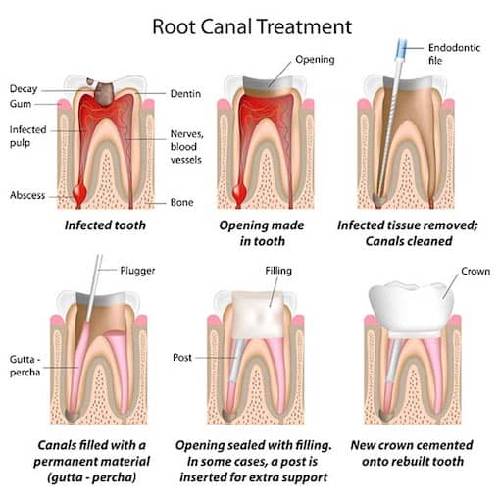- +91 9869419401 022 2544 1868
ROOT CANAL
What is a Root Canal?
- A root canal is a treatment used to repair and save a tooth that is badly decayed or becomes infected.
- During root canal procedure, the nerve and pulp are removed and the inside of the tooth is cleaned and sealed. Without treatment, the tissue surrounding the tooth will become infected and abscesses may form.
- "Root canal" is the term used to describe the natural cavity within the center of the tooth. The pulp or pulp chamber is the soft area within the root canal. The tooth's nerve lies within the root canal.
- A tooth's nerve is not vitally important to a tooth's health and function after the tooth has emerged through the gums. Its only function is sensory -- to provide the sensation of hot or cold. The presence or absence of a nerve will not affect the day-to-day functioning of the tooth.

When Root Canal Is Needed?
Sometimes no symptoms are present; however, signs you may need a root canal include:
- Severe toothache pain upon chewing or application of pressure
- Prolonged sensitivity/pain to heat or cold temperatures (after the hot or cold has been removed)
- Discoloration (a darkening) of the tooth
- Swelling and tenderness in the nearby gums
- A persistent or recurring pimple on the gums
What Happens During a Root Canal?
- A root canal requires one or more office visits and can be performed by a dentist or endodontist
- The first step in the procedure is to take an X-ray to see the shape of the root canals and determine if there are any signs of infection in a surrounding bone. Your dentist will then use local anaesthesia to numb the area near the tooth.
- An access hole will then be drilled into the tooth. The pulp along with bacteria, the decayed nerve tissue and related debris is removed from the tooth. The cleaning out process is accomplished using root canal files. A series of these files of increasing diameter are each subsequently placed into the access hole and worked down the full length of the tooth to scrape and scrub the sides of the root canals. Irrigation Such as chlorhexidine or sodium hypochlorite is used periodically to flush away the debris.
- Once the tooth is thoroughly cleaned, it is sealed. At the next appointment, to fill the interior of the tooth, a sealer paste and a rubber compound called gutta percha is placed into the tooth's root canal. To fill the exterior access hole created at the beginning of treatment, a filling is placed.
What Should One Expect After the Root Canal?
- For the first few days following the completion of a root canal, the tooth may feel sensitive due to natural tissue inflammation, especially if there was pain or infection before the procedure.
How Successful Are Root Canals?
- Root canal treatment is highly successful; the procedure has more than a 95% success rate. Many teeth fixed with a root canal can last a lifetime.
Alternatives to a Root Canal
- Saving your natural teeth is the very best option, if possible. Your natural teeth allow you to eat a wide variety of foods necessary to maintain proper nutrition. The root canal procedure is the treatment of choice.
- The only alternative to a root canal procedure is having the tooth extracted and replaced with a bridge, implant, or removable partial denture to restore chewing function and prevent adjacent teeth from shifting. These alternatives not only are more expensive than a root canal procedure but require more treatment time and additional procedures to adjacent teeth and supporting tissues.


